Nelson Corporation Tramways
History
Nelson Corporation became a tramway owner on the 1st of March 1900, by virtue of its acquisition — together with Burnley Corporation, Padiham Urban District Council, Brierfield UDC, and Reedley Hallows Parish Council — of the standard-gauge, steam-operated Burnley and District Tramways Company. Each local authority paid a sum proportional to the tracks within its boundary, agreeing to lease operation to Burnley Corporation.
The B&DTCo tracks ran from the boundary with Brierfield UDC to Nelson town centre, a distance of 0.77 miles. Steam services, which were operated by Burnley Corporation, were withdrawn on the 17th November 1901, in order to begin the conversion to overhead, electric traction, and re-gauging to 4ft 0ins. The narrower gauge was chosen in the hope of connecting to other nearby systems (i.e., Accrington, Bacup, Burnley, Colne and Rawtenstall) which either already used this gauge or intended to build tramway systems that did. The first electric service over the reconstructed line commenced on the 27th March 1902, and was operated by Burnley Corporation Tramways (the lessee).
Nelson Corporation obtained powers to build and operate its own electric tramway in 1901, services commencing on the 23rd February 1903. The system totalled a mere 2.75 miles (excluding the 0.77 miles leased to Burnley Corporation) being essentially a continuation of the line from Burnley, northeastwards to meet the tracks of the planned Colne and Trawden Light Railway (from 25th March 1914, Colne Corporation Light Railways) at the Nelson-Colne boundary, with a short branch northwards from the centre of Nelson to Higherford Bridge. Whilst Nelson's tracks were connected to those operated by Burnley Corporation Tramways (in Nelson), Nelson Corporation Tramways cars did not venture south of the town. Through services were however instigated between Nelson and Colne (from 1911), with NCT tramcars working through to Colne and C&TLR (later CCLR) tramcars working through to Nelson.
Little is known about the finances of the tramway, but it can hardly have been very profitable given its very small size. Like many tramway systems, Nelson's emerged from the rigours of the Great War in run-down condition with a significant backlog of repairs and renewals. Despite high costs and inflationary pressures, the corporation invested in new tramcars, whilst introducing bus feeder services from the 1st September 1923.
By 1932, the corporations of Burnley, Colne and Nelson saw combined municipal operation as the way forward, something that they perhaps ought to have considered in 1901/2. On the 1st April 1933, Nelson's transport interests (including the trams) were transferred — together with those of Colne and Burnley — to the Burnley, Colne and Nelson Joint Transport Committee. Burnley were of course the major player in the BC&NJTC, and its views tended to be transposed onto the enterprise as a whole. Whilst Colne Corporation had begun abandoning its tramway system in 1926, and had run it down considerably since then, Nelson Corporation were very much against the idea, having replaced their entire tramway fleet barely 13 years beforehand. The majority view however prevailed, Nelson being out-voted, so tram replacement proceeded across the entire concern, Nelson included. The last tram service over former NCT tracks ran on the 6th January 1934.
Uniforms
Photographs of Nelson Corporation Tramways staff are far from common, though perhaps expectedly so given the small size of the system (2.74 miles). The first photo below indicates that staff initially wore single-breasted jackets with lapels, though somewhat unusually for a tramway system, these appear to have been worn with white shirts and bow ties! Caps were in a soft-topped, military-style with a glossy peak and bore script-lettering cap badges, either Conductor or Motorman, presumably in brass to match the buttons (see link).
Uniforms were subsequently changed (probably in the mid-to-late Edwardian era) to a more traditional tramway style. Conductors were now issued with single-breasted tunics with five buttons, two pockets (with button closures) and upright collars; in contrast, motormen wore double-breasted, 'lancer-style' tunics with two rows of five buttons and upright collars. The collars on both styles of tunic carried individual metal letters — 'N C T' — on the bearer's right-hand side, and very probably an employee number on the left, again both presumably in brass. Caps also appear to have been changed at the same time, though still military in style, they now had a tensioned crown (top); the continued to carry the same badges as the previous caps.
Tramcar staff were also issued with double-breasted greatcoats with two rows of five buttons; these had high, fold-over collars that bore an employee number on the left-hand side and individual brass 'N C T' initials on the right-hand side.
The staff photo below — if it is indeed of Nelson Corporation Tramways — indicates that inspectors wore traditional single-breasted tramway inspector jackets with hidden buttons (or more probably an hook and eye affair), all edged in a finer material than the main body, and with upright collars; the latter probably bore Inspector in embroidered script lettering, though this cannot be made out with certainty on the surviving. Caps were the same style as worn by tramcar crews, but probably bore the designation Inspector, once again in embroidered script lettering.
In common with many tramway systems, it is highly likely that Nelson employed female staff during the Great War to replace male staff lost to the armed services; however, photographs are yet come to light, so it is impossible to say what uniforms were worn.
Further reading
For a history of Nelson transport, see: 'Burnley, Colne and Nelson Joint Transport' by A Catlow; Wyvern Publications (1984).
Images
Motormen and conductors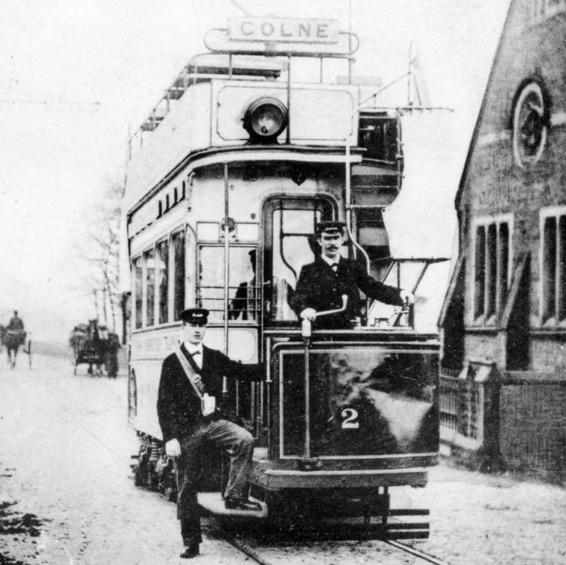
A conductor and a motorman pose on the platform of a rather battered looking Tramcar No 2 at the tram terminus at Reedyford, Nelson, with a service for Colne — photo undated, but probably taken in the early Edwardian era. Both men are wearing single-breasted jackets with lapels and what would appear to be bow ties. With thanks to Jim Halsall.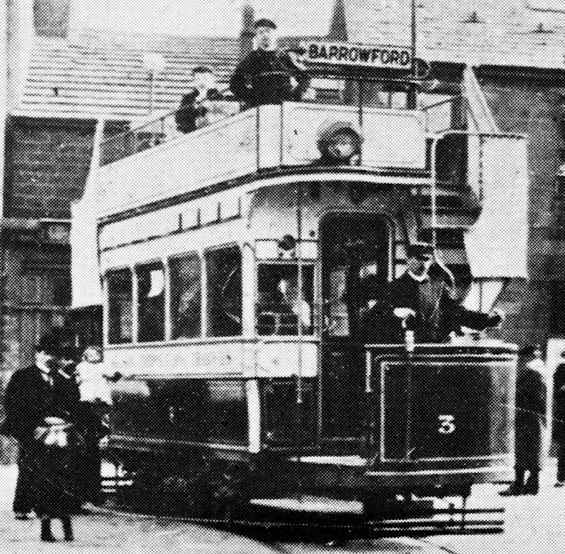
An early photo of Tramcar No 3 bound for Barrowford — photo undated, but probably taken in 1900. The motorman is wearing a soft-topped cap and what appears to be a greatcoat. Photo courtesy of the Tramways and Light Railway Society.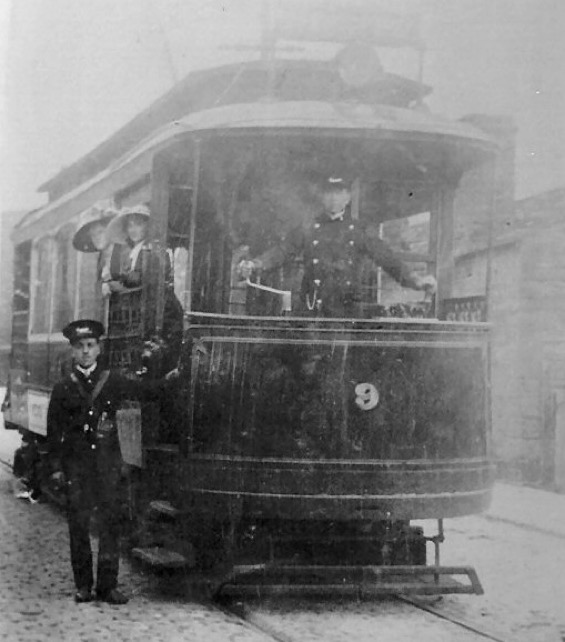
A conductor and a motorman with single-deck bogie combination car No 9 — photo undated, but probably taken in the late Edwardian era. With thanks to Jim Halsall.
Standard script-lettering cap badges of the pattern used by Nelson Corporation Tramways — brass. Author's Collection.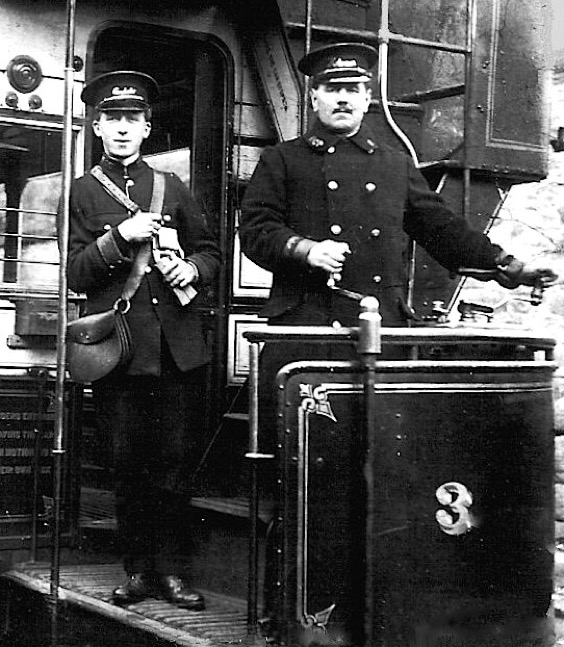
A conductor and motorman pose for the cameraman on the platform of Tramcar No 3, with the service for Higherford — photo undated, but probably taken shortly before the Great War. The individual 'N C T' collar initials are clearly in evidence. With thanks to Jim Halsall.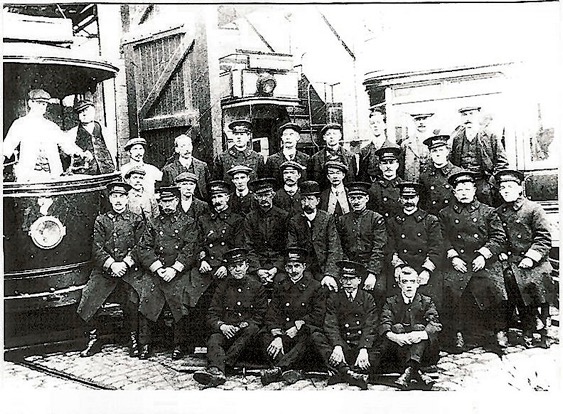
A very poor quality image, but one which probably depicts most of the staff of Nelson Corporation Tramways assembled at the depot — photo undated, but almost certainly taken before the Great War. With thanks to Jim Halsall.